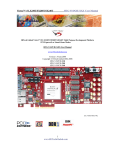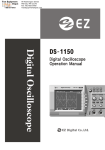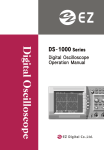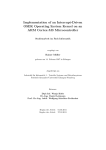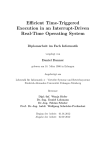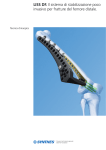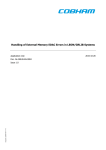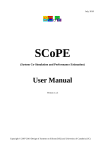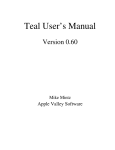Download Hardware/software debugging of large scale many-core
Transcript
Hardware/software debugging of large scale many-core architectures Stephanie Friederich, Jan Heisswolf, Jürgen Becker Karlsruhe Institute of Technology Karlsruhe, Germany Email: [email protected] Abstract—The size of current multi-processor system-on-chip (MPSoC) is growing unsustainable. Besides, new decentralized software approaches are being developed to handle the management of increasing resources. To verify the system functionality of these novel hardware/software systems, sufficiently accurate models are required. However, current simulation tools have limited scalability and performance; hence hardware prototypes and debugging concepts are necessary for system verification. We present a novel debug approach which offers visualization of hardware/software interaction for system level verification. The debug concept comprises debug probes within each router of the network as well as monitoring units to trace the activity of each core in the MPSoC. In addition a transactor based method is proposed to transmit the huge amount of debug information out of the hardware prototype to evaluate the information on a standard host computer. Experimental results show that the resource overhead is insignificant in contrast to the gain of extensive debug possibilities. Furthermore the number of pins required for the presented debugging concept is kept constant independent of the architecture size and thus we are not facing problems of limited debug interfaces or pins. In comparison to conventional debugging we show improvements in scalability and bandwidth. I. I NTRODUCTION One of the challenges in modern multi-core system design is the connection of prototyping platforms into system-onchip (SoC) modeling environments. The development of new hardware requires early system debugging and verification methods, but due to system complexity this task gets more and more complicated. To accelerate the overall multi-core SoC design development process, early software development is one of the crucial factors but only possible if simulation models or a prototype of the system is available. Because register-transfer level (RTL) simulation is too slow for designs consisting of millions of transistors, prototyping on a fieldprogrammable gate array (FPGA) platform is one way to speed up the development process of new hardware architectures. But the implementation of the design in hardware leads to new problems. Restricted hardware resources, such as limited memory and gates lead to restricted size of the design under test. In addition due to lack of physical interfaces the debug possibilities are also constricted. Another challenge is to verify both the logic of the hardware design as well as the embedded software. The hardware design contains multiple processors, different memory systems and complex interfaces. To speed up the development of operating systems and software drivers it is necessary to have a working prototype of the hardware design as soon as possible. Having such a hardware prototype it is then possible to boot the operating system and validate that the software runs properly. But one question arises here, how do we get the software into our system and execute the software? FPGA prototyping is widely used in semiconductor design. The verification of simple and small designs could be made with common FPGA evaluation boards. If it comes to bigger designs prototyping platforms with multiple FPGAs are used. In case of this paper we are using the CHIPit prototyping platform from Synopsys, which includes six Virtex5 FPGAs. Common rapid SoC FPGA-based prototyping hardware platforms like Haps 70 series from Synopsys [1] and V7 TAI Logic Module from S2C [2], as well as the CHIPit system, do not have many interfaces. Even custom designed prototyping platforms are not capable to provide as many interfaces as a multi-processor design with hundreds of cores would require. Hence it would not be possible to debug all processors on core level. Previous debug modules did not give the possibility to trace the processor instructions as well as the network communication. The Gaisler LEON system originally did not include a NoC system and hence one connection for the debug support unit was sufficient. Novel tile based NoC systems require more than one debug support units and therefore it is hardly possible to connect every unit with one physical interface. The Universal Multi-Resource Bus (UMRbus) based approach allows to have as many interfaces in the design as we want. The paper is organized as follows: the following section describes related work on NoC debugging techniques, extending the number of debug interfaces, and a multi-core hardware architecture which was used in the following sections. Section three describes the implementation of the transactor and the integration into the debug unit as well as the debug extension of the router. The experimental results are presented in section four. The last section presents a forecast of upcoming work. II. R ELATED WORK To enable core level debugging, several debug interfaces are required within the network. With huge NoC sizes, available interfaces on common FPGA development boards are not sufficient anymore and hence other solutions to increase the number of debug interfaces need to be found. This section first describes conventional network debugging methods and then techniques to increase the number of interfaces are presented. A. NoC debugging techniques The observation of the communication within a NoC-based architecture is crucial for different reasons: (1) tuning and debugging of applications, (2) identification of bottlenecks / system debugging, (3) analysis of deadlock situations and (4) debugging of the communication hardware. Different monitoring concepts for NoC-based architectures have been proposed in the past, most of all to observe the network communication: In [3] a concept for system-level and application debugging was introduced. It uses monitoring probes that model the monitored information in the form of time stamped events. The proposed monitoring system is suitable for application debugging (1) and system debugging (2). Low level debugging (3+4) is not addressed. Another monitoring design template is presented in [4]. It can be used for performance analysis and debug of the interactions of a embedded NoC processors architecture. A generic template for bus and router monitoring is introduced. However, the presented monitoring infrastructure only comprises -high level debugging and monitoring (1+2). Debugging and analysis of early software and hardware prototypes necessitates a more detailed analysis of the communication. Deadlock situations might occur and need then to be analyzed. There are several reasons for deadlocks, ether they result from hardware bugs or conceptual weaknesses in the software layers. Such detailed observability (3+4) have not been addressed explicitly yet. Time consuming conventional hardware debugging by the use of logic analyzers or FPGA analyzers (e.g. Xilinx ChipScope) were often used for detailed analysis. In contrast, our concept for detailed NoC debugging is very simple to use. It is detailed in Section III-E1 and Section III-D. In [5] an approach to online debug for NoC-based multiprocessor SoCs is introduced. The described debug infrastructure allows investigating and to debug the behavior of an NoCbased SoC at run-time. B. Virtual interfaces for debugging Growing NoC systems require more and more debug interfaces but common prototyping platforms only offer a limited amount of interfaces. One possibility to increase the number of interfaces is the implementation of virtual interfaces, in [6] one implementation has been described. Thereby all cores of the system are connected to an Advanced eXtensible Interface (AXI) bus. The bus is then connected to one core that is responsible for UART communication. All communication with the host computer is redirected through the core with the UART connection (it is named embedded virtual server). This core is connected with the host computer by a conventional serial line. Virtual UARTs provide each single process access to its own serial connection. However, this concept only addresses designs where all processors are connected to the same bus. Due to the partitioned design over multiple FPGAs, which is described in this work, the concept of virtual UARTs would not be feasible. Another drawback of the virtual UART concept is the limitation of the bandwidth to the host computer due to the use of a single UART connection. Another alternative of virtual interfaces is a transactor based approach. In [7] the prototyping of a heterogeneous multiprocessor system-on-chip (MPSoC) design, which consists of general purpose RISC processors as well as novel accelerators in form of tightly-coupled processor arrays (TCPA), is described. The focus of this work was the transactor based debugging and verification of the TCPA component. A single AMBA AHB transactor is used to realize one data connection between software running on a host PC and the hardware on the FPGA board. As described in section III-C we use this approach and extend it by using multiple transactors, since a scalable NoC based architecture was not considered yet. C. Invasive computing Invasive computing is a novel paradigm for designing and programming future parallel computing systems. For systems with more than 1000 cores on a single chip, resource-aware programming is of utmost importance to obtain high utilization as well as computational and energy efficiency numbers. With CPU CPU CPU CPU CPU CPU CPU CPU CPU CPU CPU CPU Memory i-NoC Router Memory i-NoC Router CPU Memory i-NoC Router CPU Memory CPU CPU and CPU CPU CPU CPU I/O Memory i-NoC Router Memory i-NoC Router CPU CPU CPU CPU CPU CPU CPU CPU CPU CPU CPU CPU Memory i-NoC Router Fig. 1. i-NoC Router Memory Memory i-NoC Router i-NoC Router InvasIC Network on Chip (NoC) hardware architecture this goal in mind, invasive computing was introduced to give a programmer explicit handles to specify and argue about resource requirements in different phases of execution. To support this idea of self-adaptive and resource-aware programming, new programming concepts, languages, compilers, operating systems, and hardware architectures have been developed within the invasive research project. The invasive hardware design of a MPSoC (multiprocessor systems-on-achip) includes profound changes to support efficiently invasion, infection, and retreat operations. [8], [9] The invasive Network on Chip (i-NoC) [10] builds the communication infrastructure of the InvasIC architecture. It is a wormhole packet switching network with Virtual Channels (VCs) providing Quality of Service (QoS) communication by the use of end-to-end connections as detailed in [11]. The iNoC consists of two basic components - the network adapter (NA) and the routers which are connected via links. The iNoC routers [12] build a meshed topology and are responsible for the data transmission between the tiles. Therefore a distributed routing scheme is realized to ensure scalability of the architecture. The network adapter attaches the i-NoC to the tile internal bus system. It has a memory mapped interface and is responsible for transparent fetching of data from tile external memories, generation of special system messages and management of the i-NoC features. The tiles itself could be of various types. Simple compute tiles with multiple processors, memory and IO tiles, and also special hardware accelerator tiles. Figure 1 shows one possible implementation of an invasive hardware architecture. The compute tile internal concept is based on the Gaisler IP library [13]. It consists of several LEON3 processor cores, different memories and several peripherals all connected to a tile local AMBA Advanced High-performance Bus (AHB). In addition each tile has a monitoring and a debug (DSU) unit, as well as an AHB master transactor. The Ethernet and DDR2 memory controller are optional components, which are added in case of a Memory and I/O tiles. Figure 2 shows one possible implementation of the tile architecture. There are many higher performance, processors on the market, but most of them are LEON 3 CPU LEON 3 CPU LEON 3 CPU FPU L1 FPU L1 FPU L1 FPU L1 FPU L1 MMU MMU MMU MMU MMU L2 Cache 128kB AHB Ethernet (optional) DDR2 DSU Controller (optional) AHB/APB bridge Transactor SRAM Monitor Controller (TLM) APB UART Timer Interrupt controller Message In Port Proxy 1 Message In Port Proxy 3 DUT Message In Port 1 Transactor 1 Message Out Port 2 Message Out Port Proxy 2 Software side Host workstation Fig. 3. Fig. 2. DUT Proxy Testbench module 1 LEON 3 CPU Testbench module 2 Network adapter LEON 3 CPU UMRbus Message Out Port Proxy 4 Message In Port 3 Message Out Port 4 Clock/ reset generation and control Transactor 2 Hardware side (emulator) CHIPit Platform UMRBus transactor model Single compute tile architecture not available as HDL source code. Therefore, we decided to use the LEON3 processors as well as other components of the Gaisler GRLIB. It is released in open-source under the GNU GPL license. Since our architecture is built in a modular way, it is easy to exchange the LEON core with any other processor core with an AHB interface later. D. LEON3 processor debug interface The Aeoroflex Gaisler tool GRMON2 [14] is a general debug monitor for LEON3 processors, and for SoC designs based on the GRLIB IP library. The Debug Support Unit (DSU) provides a non-intrusive debug environment for the Leon-Cores on real target hardware. The LEON3 DSU can be controlled through any AMBA AHB master in a systemon-chip design. The debug interface can be of various types: serial UART, Ethernet or as described in section III-C, also user defined interfaces can be used. The GRMON2 monitor interfaces to the on-chip debug support unit (DSU), implementing a large range of debug functions. These functions are for example upload and execution of LEON applications, built-in disassembler and trace buffer management, and read and write access to all system registers and memory which are accessible in the tile local address range. Since the GRMON2 debug monitor is intended to debug system-on-chip (SOC) designs but not network-on-chips (NoC) designs, it is necessary to have multiple DSU and GRMON2 instances in NoC designs such as the invasive hardware architecture. III. C ONCEPT The concurrent development of novel hardware and software components requires debugging on several levels to verify the system functionality. The integration of hardware components into one design causes errors, even if the single components have been verified before. Also some errors only occur during the interaction of hardware and software. To detect these kind of errors, in detail system level verification is required, but due to the size and complexity of currents systems quite comprehensive. The following section describes on the one hand the concept of using an AHB master transactor to exchange data between a software running on the host machine and the hardware design configured on the FPGAs of the CHIPit system. And on the other hand the novel NoC based debugging technique is presented. A. CHIPit Platinum edition The CHIPit Platinum Edition System is a high-capacity, high-speed emulation and rapid prototyping system for ASIC designs. It contains six Xilinx Virtex-5 LX330T FPGAs which is equivalent to 12 million ASIC gates; furthermore the platform can be extended up to 18 FPGAs. On the top of the prototyping system there are extension board interfaces to plug in up to six extension boards, such as memory, Ethernet and other interfaces. In addition to the extension board interfaces, the CHIPit platform is connected to a host computer via the UMRbus (Universal Multi-Resource bus). This bus builds the interconnection for transactor based communication where hardware running on the CHIPit FPGAs is connected to software which is executed on the host computer. The transactor based communication builds the background of the debugging interface which is described in this paper. The maximum clock frequency of the FPGA platform is defined to 100MHz, due to the clock latency between FPGAs. More details about the CHIPit platform and its use for many-core prototyping are provided in [15]. B. UMRbus AHB master transactor The Synopsys Transactor Library for AMBA is the link between AMBA based user designs and the software environment on a PC host machine. The connection between the AMBA bus on the FPGA side and software running on a host PC is provided by the UMRbus. With respect to the AMBAbased LEON3 cores that are used in our prototype, these transactors play an important role as detailed later. The library packet includes several AMBA transactors, such as master and slave components for different bus systems, including AHB and AXI. The library package includes the hardware IP for each transactor as well as a C++ library; hence the user does not need to care about the UMRbus implementation. The user only needs to configure the transactor for its own purpose and integrate it into the project. For more information about the Transactor Library see [16]. The UMRbus based transactor model is shown in figure Figure 3. The left side represents the software part with multiple software instances and the right side represents the hardware adapter and the design under test (DUT). In the middle lies the UMRBus driver which connects the hardware and software side. Since the communication over the UMRbus is carried out in a serial way, each transactor includes two FIFOs to store incoming and outgoing messages. The inport FIFO holds data packets while the AHB bus fabric processes them. While the outport FIFO queues the messages while the UMRbus is busy. Both FIFO sizes could be customized in the range of 16 to 4095 32-bit words. Figure 4 shows the connection of the transactor hardware components. Each component inside one FPGA is connected in a serial way, as well as the communication between FPGAs and the UMRbus UMRBus rst UMRBus out FPGA 2 UMRBus component 9 UMRBus component 8 FPGA 5 UMRBus component 6 UMRBus component 5 UMRBus component 4 FPGA 1 FPGA 6 Fig. 4. UMRBus component 3 UMRBus component 2 UMRBus clk UMRBus component 1 UMRBus in UMRbus communication interface communication interface is also serialized. Hence each FPGA requires only one set of UMRbus signal independent of the number of transactor instances inside the FPGA. FPGA 3 UMRBus component 7 FPGA 4 UMRBus connection over FPGA boundaries C. GRMON connection with the AHB transactor As described in section II-D the LEON3 processor comes with its own debugging unit (DSU) which can be connected to the debug tool GRMON2 to access debug information. The default communication interface between GRMON2 and the system running on an FPGA is a serial interface connected to the AHB UART of the target system. Since our prototyping platform only has two serial interfaces, and it is required to have a connection to each individual tile, we need to apply other interfaces to connect GRMON2. In addition to the supported debug communication interfaces, it is possible to add a custom interface using a loadable module. The custom interface only needs to provide functions to read and write data on the AHB bus, which is equivalent to an AHB master interface. Hence we are using the AHB master transactors of the Synopsys transactor library to connect GRMON2 with the AHB bus on each tile. Only once a loadable module must be compiled into a shared library which includes read and writes function as well as an initialization of the transactor. The user than can start GRMON2 in a common way with the shared library and the tile ID as parameters. Now it is possible to run multiple sessions of GRMON2 in parallel, all linked with the UMRbus. Another advantage of the UMRbus connection, even with multiple GRMON2 instances, is the much higher data rate than a system with one serial connection per GRMON instance. This high data rate improves the usability of the prototype (e.g. if large binaries are loaded to the architecture). The GRMON2 connection could also be used to transfer the monitoring data of the network, which is described in the following section. Thus there is no need for an additional interface. D. Concept for NoC debugging Especially in early phases of a hardware development process hardware units might contain bugs that have not been recognized while simulating the design. Thus, these bugs make their way into the first FPGA-based prototypes of the architecture. Such bugs might only show up in case of complex software scenarios executed on the parallel architecture. Drawing inferences from the erroneous behavior of the software about the source of the error is often impossible without detailed investigation. Executing a complex parallel software on simulated hardware is too time consuming. Thus, realtime debugging of the hardware is required to find bugs in a reasonable time. In case of a Network on Chip, a detailed analysis of the data transfers can help to localize a hardware bug or an error resulting from an misapplication by the software1 . For such an analysis the latest data on the NoC need to be analyzed after an error occurred. Therefore a history of the latest data needs to be available. This history can be accessed on demand once an error occurred to analyze what was going on under the hood triggering the error. For a detailed analysis we propose one separate history per router port. Thus, a packet will be captured by multiple debugging histories. This help to localize a potential hardware bug and gives an indication on the faulty component. The debugging history needs to be accessible even when the cores crashed and cannot be used for software execution anymore. In combination with GRMON2 and the transactor based communication (see Section III-C) it is possible to access the memory mapped debug registers directly. More details about the realization of the NoC debugging infrastructure are given in Section III-E1. E. Implementation Figure 1 shows the implemented architecture with the tile internal structure shown in figure 2. Since each tile contains five LEON3 cores, the implemented design comprises 45 cores. Single FPGAs are too small to enclose the complete design. Thus we partitioned the design and distributed it over six FPGAs. Due to our memory map concept with the same address range inside each tile, it is necessary to insert one debug support unit into every tile, thereby we have access to the entire address space in our system. The CHIPit prototyping system does not have as many physical interfaces as it is required for inserting one debug support unit into every tile. Hence we are using the transactor based approach as described in the previous section. We include one I/O transactor into every tile on the hardware side. On the software side on our host PC we connect one GRMON2 monitor to each transactor. To connect the AHB transactor with GRMON2 [14] we created a shared object library, which get the transactor ID as an input value. To load the module which includes the custom interface, the shared object library as well as the tile ID to which we want to build the connection has to be added as parameters when opening a GRMON2 monitor. The following shows the command to start GRMON2: ./grmon -dback my io.so -dbackarg Tile ID After starting GRMON2, the UMRbus interface will be initialized. Afterward data could be read and written to any memory location which is implemented and accessible through the AHB bus. 1) NoC debugging implementation: To enable real-time debugging of the communication of the invasive Network on Chip, a debug queue is realized at each router input port and at the local output port, as shown in Figure 5. Each queue is realized as a shift register that drops the oldest value to store the latest data. The queues at the input ports help to check the data arriving from the neighboring routers or from the network adapter in case of the local port. The additional queue at the output port helps to check whether data have left the NoC valid or corrupted. The size s of each queue depends on the required length of the history that needs to be captured and can be set at design time. In Section IV-A2 the impact of s on the resource requirements is investigated. 1 During the development of the i-NoC multiple bugs have been found by real-time analysis of the communication data. Compared to ChipScope that was used before, the NoC debug registers improved debugging speed significantly. In Ports Debug Queue Buffer Buffer Buffer Buffer Routing Reservation Table Out Ports Debug Queue Port 1 Debug Queue Port N UMRbus UART Virtual UART 103 Buffer Buffer Buffer Buffer Port 1 102 101 Port N Transmission Control 100 21 23 Block diagram of the i-NoC router with debugging extension Each time a flit arrives at a router input port or leaves the local port, a copy is forwarded to the respective debug queue. It is stored in the queue in combination with additional information (e.g. the ID of the used VC or the type of flit). In case of an error the latest flits transferred on each link can be access by a memory mapped interface that enables access to all entries of the debug queue. This interface is part of the NA and is connected to the AHB bus to access the information via GRMON. A dedicated connection between the each router and the connected NA is realized to forward the requested debugging data to the memory mapped interface. IV. A. Resource overhead 1) AHB transactor overhead: Including the AHB transactor into each tile, there is a small overhead of resources in contrast of using only serial interfaces. The size of inport and outport FIFOs inside the transactor module could be custom parameterized and hence the consumption of BRAM varies. Table I shows the resource consumption of our AHB transactor implementation in contrast to an UART. The number of pins used by one transactor component is also higher than for one simple serial interfaces, but if more than one transactor component is placed into one FPGA, they all share the same pin resources. Figure 6 shows the pin utilization, in terms of different number of tiles, for implementation with serial interfaces, our UMRbus based concept, and the virtual UART [6]. TABLE I. D ESIGN SPACE EXPLORATION OF DEBUGGING ALTERNATIVES LUTs Register BRAM IO pins Virtex5LX330 189,183 207,360 288 1,200 UART interface 336 184 0 2 AHB IO transactor 3744 (1,98%) 3699 (1,78%) 7 (2,43%) 20 (1,67%) 2) NoC debugging overhead: Table II gives the synthesis results of a single router, using a Virtex-5 LX330T FPGA as target device. It analysis the overhead of the proposed NoC debugging infrastructure. Therefore a single router was synthesized without debugging support and with a debug 29 UMRbus UART Virtual UART 105 E XPERIMENTAL R ESULTS To identify bugs in the whole architecture, every tile includes one debug support unit. Thus it is possible to connect one GRMON2 debug monitor to every single tile. This gives us the possibility to load and run software individually in every tile, as well we can get detailed core and bus information of all tiles. 25 27 Number of tiles Fig. 6. Required FPGA or ASIC pins for realization of different debugging alternatives Bandwidth Fig. 5. Transmission Control Pin count Reservation Table Routing 104 103 102 21 Fig. 7. 23 25 27 Number of tiles 29 Bandwidth of different debugging alternatives history table size of 64 and 128 entries. The results show that the additional resource requirements for debugging are small and grow linear with the size of the debug queue. For a queue with 64 entries only 3.6% additional LUTs and 8.5% more registers are required compared to the reference. Moreover, the debugging support might be only enabled in early design phases and can be omitted later to save resources and power. TABLE II. OVERHEAD ANALYSIS FOR THE PROPOSED N O C DEBUGGING INFRASTRUCTURE Router version Debugging off Debug (64 entry) Debug (128 entry) Frequency (M Hz) 105.6 105.3 (-0.3%) 107.1 (+1.4%) Slices LU T s Registers 10704 4502 11092 (+3.6%) 4886 (+8.5%) 11441 (+6.9%) 5269 (+17.0%) B. System performance Considering the performance of system components, we see that software on the host side runs at GHz speed. The FPGAs design runs with a lower frequency at 25MHz and the UMRBus communication link is running at 70MHz, but because of a long latency of the link, the transmission rate could be translated roughly to 100 KHz. However, it is possible to achieve a maximum data rate of 100 Mb/sec, by using asynchronous communication across the link and by transferring large packets over the UMRBus. Since we use serial transmission of the transactor data, the data rate decrease if all transactors are transferring data at Future work will compromise a bigger NoC design. But this requires bigger prototyping platforms and a new tool flow which includes pin multiplexing. In addition, instead of using usual FPGA IO pins, high speed interconnects could be used for transferring the UMRbus data to increase the bandwidth again by more than three times. Since the increasing number of debugging interfaces will not protect the user from confusion because of the huge number of debugging screens, an implementation of new NoC based debugging concepts are planned, where all debugging information is transmitted through one single I/O tile. ACKNOWLEDGMENT This work was supported by the German Research Foundation (DFG) as part of the Transregional Collaborative Research Center ”‘Invasive Computing” (SFB/TR 89). R EFERENCES Fig. 8. GRMON2 debug window at system start-up [1] [2] the same time. But since parallel debugging of all processors is not necessary on the one hand and on the other hand the debug information does not compromise huge data sets, the data transmission rate is not that affected during debugging. Only if huge amount of data is transferred at the same time, the transmission rate of a single transactor decreases. Figure 7 illustrates the bandwidth of the debugging interfaces according to the number of tiles in the design. Our experimental tests only considered designs with maximum of nine tiles. Thereby we could observe that the accumulated bandwidth decreases if we are using one UMRbus connection for multiple FPGAs. C. Debugging [3] [4] [5] [6] [7] Figure 8 shows an example view of the GRMON2 connections. At start-up, information of tile internal components are reported. Because we need to open one GRMON2 connection for each tile, we implemented a simple script to open all monitors at once in one screen window. At the bottom of the screen in figure 8, the tile ID of the current view is highlighted. It is also possible to load and run applications automatically after opening the connection. Thus the user only need to start the script once and then only need to interpret the different monitoring data printed in the debug window. The debugging process of complex NoC systems is still a time consuming task, but thanks to the given comprehensiv monitoring information, also bugs could be detected whose cause of error happens a huge space of time before the bug is visible to users. [8] [9] [10] [11] [12] V. C ONCLUSION & F UTURE W ORK In this paper, we presented an FPGA based debugging methodology for large scale many-core architectures. The resulting prototype of the invasic architecture was used for proof of concept and data rate measurements. In contrast to other solutions, the transactor based debugging only requires one physical interface while most other solution need as many interfaces as the number of debugging units in the design. Thus we are not facing problems because of the lack of interfaces. Another advantage of the UMRbus to conventional interfaces is the considerable increase of the bandwidth. Also we extended the network routers by debugging probes to get deeper insight in the network communication. [13] [14] [15] [16] Synopsys. (2013) Synopsys haps-70 series. [Online]. Available: http://www.synopsys.com “S2c v7 tai logic module.” [Online]. Available: http://www.s2cinc.com/ Product.htm C. Ciordas, T. Basten, A. Radulescu, K. Goossens, and J. Meerbergen, “An event-based network-on-chip monitoring service,” in High-Level Design Validation and Test Workshop, 2004. Ninth IEEE International, Nov. 2004, pp. 149 – 154. B. Vermeulen and K. Goossens, “A network-on-chip monitoring infrastructure for communication-centric debug of embedded multi-processor SoCs,” in International Symposium on VLSI Design, Automation and Test, 2009. VLSI-DAT ’09, Apr. 2009, pp. 183–186. G. Fey and M. Dehbashi, “Transaction-based online debug for nocbased multiprocessor socs,” 2014 22nd Euromicro International Conference on Parallel, Distributed, and Network-Based Processing, vol. 0, pp. 400–404, 2014. P. Bomel, K. Martin, and J.-P. Diguet, Virtual UARTs for Reconfigurable Multi-processor Architectures, ser. IPDPSW ’13. Washington, DC, USA: IEEE Computer Society, 2013. S. Boppu, V. Lari, F. Hannig, and J. Teich, “Transactor-based prototyping of heterogeneous multiprocessor system-on-chip architectures,” in Proceedings of the Synopsys Users Group Conference (SNUG), 2013. J. Teich, J. Henkel, A. Herkersdorf, D. Schmitt-Landsiedel, W. Schröder-Preikschat, and G. Snelting, “Invasive computing: An overview,” in Multiprocessor System-on-Chip. Springer, 2011. J. Heisswolf, A. Zaib, A. Zwinkau, S. Kobbe et al., “CAP: Communication aware programming,” in Proceedings of the The 51st Annual Design Automation Conference on Design Automation Conference, ser. DAC ’14. New York, NY, USA: ACM, 2014, p. 105:1105:6. J. Heisswolf, A. Zaib, A. Weichslgartner et al., “The invasive network on chip - a multi-objective many-core communication infrastructure,” in 2014 27th International Conference on Architecture of Computing Systems (ARCS), 2014. J. Heisswolf, R. König, M. Kupper, and J. Becker, “Providing multiple hard latency and throughput guarantees for packet switching networks on chip,” Computers & Electrical Engineering, 2013. J. Heisswolf, R. Konig, and J. Becker, “A scalable NoC router design providing QoS support using weighted round robin scheduling,” in 2012 IEEE 10th International Symposium on Parallel and Distributed Processing with Applications (ISPA), Jul. 2012, pp. 625–632. A. Gaisler. (2013) GRLIB IP Core Users Manual. [Online]. Available: http://www.gaisler.com/products/grlib/grip.pdf ——. (2014) GRMON2 User’s Manual. [Online]. Available: http: //www.gaisler.com/doc/grmon2.pdf J. Becker, S. Friederich, J. Heisswolf, R. Koenig, and D. May, “Hardware prototyping of novel invasive multicore architectures,” in Design Automation Conference (ASP-DAC), 17th Asia and South Pacific, 2012. Xactors reference, www.synopys.com, 2013.







